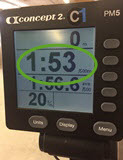500m Split. What does it mean?

For the on-water rowing community, the common measure of pace is generally “time per 500 meters,” which can be more clearly stated as “how long it takes you to row 500 meters.” This traditional measure has been brought indoors to the erg as well, and is now used by a majority of indoor rowers. But what does it mean? Why is it used? What are the other options?
It’s similar to the way runners talk about pace. If you can run a 6-minute mile (which can be written as 6:00/mile), it is faster than an 8-minute mile (8:00/mile). Runners talk about “time per mile” while rowers talk about “time per 500m.” The smaller the number, the shorter the time, and the faster you are going.
Why do rowers tend to split up workouts into 500m intervals instead of miles? The Olympic rowing race distance is 2000m. Mentally, many athletes split up that 2000m into four segments of 500 meters. Race strategies can vary, but the four segments often include a sprint start, a middle 1000–1250 meters at “race pace” (a hard but sustainable effort), and a 250–500 meter sprint to the finish.
On-water rowers are often gauging their progress based off their 500 meter split time, since this is used in racing. For example, if you are gunning to break eight minutes in a 2k race, then workouts are often based at or around the 2:00/500m pace. This measurement becomes ingrained and precise with practice. To work on intensity, rowers will also try to row at this pace at a variety of strokes per minutes (s/m on the Performance Monitor).
But if pace just doesn’t make sense for you, the Performance Monitor on the Concept2 Indoor Rower provides you with different display options so that you can measure your performance in many different ways. With a setting like Calories, the harder you row, the more Calories you burn. Watts measures power and can be comparable to other exercises, such as cycling.
What pace can or should you row at? With practice, you will be able to hone in on your pace for different distances. Ideally, your pace should be faster for short sprints than for longer pieces. I have found that my running times on the track are close to predicting my rowing fitness. My pace per lap on the track (400m) is close to my 500m split. Given that a boat “glides” over water, these distances per effort are loosely correlated.
Whatever measurement you use, repeated workouts with that unit of measure breeds familiarity. Soon you will know what a 1:45/500m split feels like, or the effort of an 800-watt stroke, or the satisfaction of burning 450 Calories. You can change between units at any time to get a sense of what works best for you.
